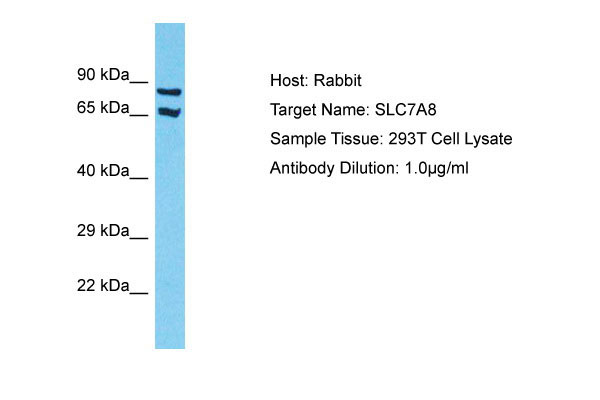SLC7A8 Antibody - N-terminal region
Rabbit Polyclonal Antibody
- 产品详情
- 实验流程
- 背景知识
Application
| WB |
|---|---|
| Primary Accession | Q9UHI5 |
| Reactivity | Human, Horse, Bovine |
| Predicted | Human, Horse, Bovine |
| Host | Rabbit |
| Clonality | Polyclonal |
| Calculated MW | 58382 Da |
| Gene ID | 23428 |
|---|---|
| Other Names | Large neutral amino acids transporter small subunit 2, L-type amino acid transporter 2, hLAT2, Solute carrier family 7 member 8, SLC7A8, LAT2 |
| Format | Liquid. Purified antibody supplied in 1x PBS buffer with 0.09% (w/v) sodium azide and 2% sucrose. |
| Reconstitution & Storage | Add 50 &mu, l of distilled water. Final Anti-SLC7A8 antibody concentration is 1 mg/ml in PBS buffer with 2% sucrose. For longer periods of storage, store at -20°C. Avoid repeat freeze-thaw cycles. |
| Precautions | SLC7A8 Antibody - N-terminal region is for research use only and not for use in diagnostic or therapeutic procedures. |
| Name | SLC7A8 (HGNC:11066) |
|---|---|
| Function | Associates with SLC3A2 to form a functional heterodimeric complex that translocates small and large neutral amino acids with broad specificity and a stoichiometry of 1:1. Functions as amino acid antiporter mediating the influx of extracellular essential amino acids mainly in exchange with the efflux of highly concentrated intracellular amino acids (PubMed:10391915, PubMed:11311135, PubMed:11847106, PubMed:12716892, PubMed:15081149, PubMed:15918515, PubMed:29355479, PubMed:33298890, PubMed:34848541). Has relatively symmetrical selectivities but strongly asymmetrical substrate affinities at both the intracellular and extracellular sides of the transporter (PubMed:11847106). This asymmetry allows SLC7A8 to regulate intracellular amino acid pools (mM concentrations) by exchange with external amino acids (uM concentration range), equilibrating the relative concentrations of different amino acids across the plasma membrane instead of mediating their net uptake (PubMed:10391915, PubMed:11847106). May play an essential role in the reabsorption of neutral amino acids from the epithelial cells to the bloodstream in the kidney (PubMed:12716892). Involved in the uptake of methylmercury (MeHg) when administered as the L-cysteine or D,L-homocysteine complexes, and hence plays a role in metal ion homeostasis and toxicity (PubMed:12117417). Involved in the cellular activity of small molecular weight nitrosothiols, via the stereoselective transport of L- nitrosocysteine (L-CNSO) across the transmembrane (PubMed:15769744). Imports the thyroid hormone diiodothyronine (T2) and to a smaller extent triiodothyronine (T3) but not rT 3 or thyroxine (T4) (By similarity). Mediates the uptake of L-DOPA (By similarity). May participate in auditory function (By similarity). |
| Cellular Location | Cell membrane; Multi-pass membrane protein. Basolateral cell membrane; Multi-pass membrane protein. Note=Localized to the cytoplasm when expressed alone but when coexpressed with SLC3A2/4F2hc, is localized to the plasma membrane. Colocalized with SLC3A2/4F2hc at the basolateral membrane of kidney cortex proximal tubules and small intestine epithelia of the villi. |
| Tissue Location | Strongest expression is observed in kidney and moderate expression in placenta and brain, followed by liver, prostate, testis, ovary, lymph node, thymus, spleen, skeletal muscle and heart Also expressed in fetal liver as well as in the retinal pigment epithelial cell line ARPE-19 and the intestinal epithelial cell line Caco-2. |
For Research Use Only. Not For Use In Diagnostic Procedures.
Provided below are standard protocols that you may find useful for product applications.
BACKGROUND
Sodium-independent, high-affinity transport of small and large neutral amino acids such as alanine, serine, threonine, cysteine, phenylalanine, tyrosine, leucine, arginine and tryptophan, when associated with SLC3A2/4F2hc. Acts as an amino acid exchanger. Has higher affinity for L-phenylalanine than LAT1 but lower affinity for glutamine and serine. L-alanine is transported at physiological concentrations. Plays a role in basolateral (re)absorption of neutral amino acids. Involved in the uptake of methylmercury (MeHg) when administered as the L-cysteine or D,L-homocysteine complexes, and hence plays a role in metal ion homeostasis and toxicity. Involved in the cellular activity of small molecular weight nitrosothiols, via the stereoselective transport of L-nitrosocysteine (L-CNSO) across the transmembrane. Plays an essential role in the reabsorption of neutral amino acids from the epithelial cells to the bloodstream in the kidney.
REFERENCES
Pineda M.,et al.J. Biol. Chem. 274:19738-19744(1999).
Rossier G.,et al.J. Biol. Chem. 274:34948-34954(1999).
Borsani G.,et al.Nat. Genet. 21:297-301(1999).
Park S.Y.,et al.Arch. Pharm. Res. 28:421-432(2005).
Li W.B.,et al.Submitted (FEB-2003) to the EMBL/GenBank/DDBJ databases.
终于等到您。ABCEPTA(百远生物)抗体产品。
点击下方“我要评价 ”按钮提交您的反馈信息,您的反馈和评价是我们最宝贵的财富之一,
我们将在1-3个工作日内处理您的反馈信息。
如有疑问,联系:0512-88856768 tech-china@abcepta.com.























 癌症的基本特征包括细胞增殖、血管生成、迁移、凋亡逃避机制和细胞永生等。找到癌症发生过程中这些通路的关键标记物和对应的抗体用于检测至关重要。
癌症的基本特征包括细胞增殖、血管生成、迁移、凋亡逃避机制和细胞永生等。找到癌症发生过程中这些通路的关键标记物和对应的抗体用于检测至关重要。 为您推荐一个泛素化位点预测神器——泛素化分析工具,可以为您的蛋白的泛素化位点作出预测和评分。
为您推荐一个泛素化位点预测神器——泛素化分析工具,可以为您的蛋白的泛素化位点作出预测和评分。 细胞自噬受体图形绘图工具为你的蛋白的细胞受体结合位点作出预测和评分,识别结合到自噬通路中的蛋白是非常重要的,便于让我们理解自噬在正常生理、病理过程中的作用,如发育、细胞分化、神经退化性疾病、压力条件下、感染和癌症。
细胞自噬受体图形绘图工具为你的蛋白的细胞受体结合位点作出预测和评分,识别结合到自噬通路中的蛋白是非常重要的,便于让我们理解自噬在正常生理、病理过程中的作用,如发育、细胞分化、神经退化性疾病、压力条件下、感染和癌症。






